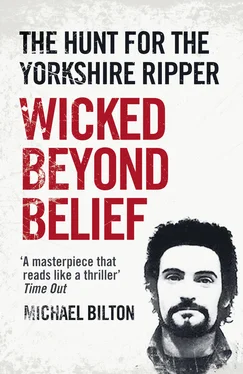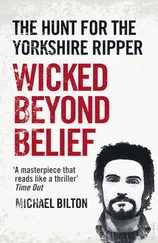In her mid-twenties she was attractive – slim and with long dark brown hair – and she liked a good time. She knew she looked alluring to men whatever she wore. Dressed in tight jeans and a blouse tied at the waist, as she was the night she died, she appeared quite vivacious. Tina – the mother of three and married so young – felt she hadn’t yet done any real living. She enjoyed men’s attention and couldn’t stop herself being unfaithful; the couple separated on a number of occasions, but then got back together for the children’s sake. Finally she left home. In 1975 she had been convicted for prostitution and her husband divorced her on 25 September 1976. He was awarded custody of the children. For a while at least Tina gave up the sex industry. She had met a man called Robert Henderson. They became lovers, but it was a strange, desultory relationship made worse by the fact that she was an alcoholic, and an uncontrollable alcoholic at that. More than that, she got into debt from accumulated fines. A short time before she was killed she went ‘back on the game’ to improve her finances.
Ten days before she was murdered, Tina rented a small flat in a purpose-built 1960s block in Oak Avenue, Manningham, close to the red-light area of Lumb Lane. The block of apartments, which had a flat bitumen and felt roof, was run down and in poor condition. Surrounded by large Edwardian houses, themselves converted into separate flats and maisonettes, the flats were built on sloping ground, two storeys high at the front and three at the back. Atkinson’s was on the ground floor at the back of the premises. To reach it from the Oak Avenue entrance you had to go downstairs.
The Friday night before she died, her boyfriend slept with her. They had sex when the effect of the previous night’s alcohol was beginning to wear off – at about four o’clock on the Saturday morning. On the Saturday night, 23 April 1977, Tina went out determined to have a good time visiting her regular drinking haunts, including the Carlisle Hotel. She had been drinking for most of the day. When the stripper who had been booked for the pub failed to turn up, Tina did an impromptu turn, climbing on to the stage. She knew she was good looking, but she was in no condition to entertain the Saturday-night crowd. Tina was totally out of control and things got rowdy. Instead of stripping down to her bra and pants, Tina took all her clothes off. An argument with the manager ensued and by 10.15 Tina was out of the door and on her way to the International Club in Lumb Lane. The last time she was seen it was by another street girl at about 11.10. Tina was weaving and staggering her way down Church Street towards St Mary’s Road, completely drunk, having consumed the equivalent of twenty measures of spirits.
The next day Robert Henderson became concerned for his girlfriend’s whereabouts and at about 6.30 on the Sunday evening decided to call at her flat. Failing to raise a response for his urgent knocking on the door, he forced his way in and made the appalling discovery of Tina’s body on the bed. She was obviously dead. He rushed to the caretaker’s and urged him to call the police.
During the inquiry, Domaille made time to meet with Tina’s ex-husband and children. ‘She had led him a terrible life,’ he said. ‘He was a Pakistani, an insignificant, ordinary fellow who did his best for her, did everything he could to help her. He wasn’t that hard up, reasonably well off money wise, but she was a bad girl.
‘I thought about why she may have gone that way, I thought about it a lot. She was in the Manningham environment where the girls get together and the girls talk. I’ve met and talked with a lot of prostitutes. They are people who have a great understanding of people in the main, a lot of them are mixed up and are to be pitied. Many girls do it because they have been driven towards it. Every now and then you meet one who is going to make her way out of it and they actually do.’ Yorkshire police officers can be as hard as nails when discussing women who take to the streets. Others working on the Yorkshire Ripper case over the years came to share Domaille’s view of most prostitutes as more sinned against than sinning. ‘Murder is murder,’ said one. ‘Even prostitutes are somebody’s daughter, somebody’s sister, maybe somebody’s wife and somebody’s mother.’
The impressions of the boot print in blood found at the bottom of the bed sheet was later thought to have come from a Dunlop ‘Warwick’ wellington boot. However, since the bed sheet was crumpled it was difficult to determine the exact size, but a match with the boot impression found at the scene of Jackson’s murder was thought possible. The flat was full of fingerprints which then had to be gradually eliminated. The previous occupants were traced and had their fingerprints and palm prints taken for elimination purposes, but no matches were found. One set of prints belonged to a man who had returned to live in Africa, who was then traced and eliminated. A total of nine fingerprints were discovered which could not be eliminated. Domaille’s team began overhauling all the ‘live’ inquiries that were still continuing from the three previous murders. Nothing emerged that assisted their effort, with one exception, and that proved a red herring.
Tina Atkinson was a frequent user of taxis – even for the shortest of journeys. Every known taxi driver in Bradford, some 1,200 of them, was interviewed by Domaille’s murder squad, along with all convicted and known prostitutes in the city. It was during this phase of the operation that the inquiry went off on a false trail. Questioning taxi drivers revealed nothing of value. But a woman called Barbara Kathryn Miller came forward to reveal she had been attacked in Bradford two years previously. The thirty-six-year-old professional stripper was known by police to be an active prostitute in Wolverhampton, Derby and Manningham. She knew Atkinson well and was anxious to help all she could. She told of a man with a beard who picked her up in a pub in Lumb Lane. He drove a Land-Rover with a hard top and a long wheelbase. She could even remember the colour: blue with a dirty cream top. It was in a dirty condition, with a six-inch tear in the black vinyl of the passenger seat and a white square petrol can and sacking behind the driver’s seat. He drove her to a quarry in the Bolton Woods area of Bradford for sex. She believed it happened on either a Wednesday or Friday night at about 9.30 in March 1975. The punter told her to get out of the vehicle, and when she refused, he dragged her out and assaulted her, punching her stomach, chest and face. Then he threw her against the vehicle, banging the back of her head. The man fled after the woman began fighting back.
Putting the experience down as a professional hazard, she failed to tell the police. But now, in answer to the appeal from Domaille for prostitutes who had dealt with violent clients to come forward, she provided detectives with a description of her attacker which in some respects matched the description of the man who tried to kill Claxton and Tracey Browne, but in other crucial areas was wide of the mark. The woman said he was thirty-five to forty years old, five feet eight inches tall, of stocky build with untidy ginger hair, a full ginger beard and moustache, but with the beard cut short under the chin. He had blue eyes, a possible Irish accent with a slight Birmingham dialect, a scar on his left hand, and a blue and red tattoo. The photofit she gave police again bore a good likeness to similar descriptions from other women. However, it was the attacker’s use of a Land-Rover to which police paid most attention. A description of a similar man had been provided by witnesses in an earlier murder. Emily Jackson was said to have been spotted getting into a Land-Rover at about seven o’clock on the night she was killed, at the junction of Roundhay Road and Gathorne Terrace. He too was described as late forties with ginger beard and a scar on his left hand. Nearly 1,250 Land-Rovers registered in West Yorkshire were eliminated, leaving 159 untraced.
Читать дальше












